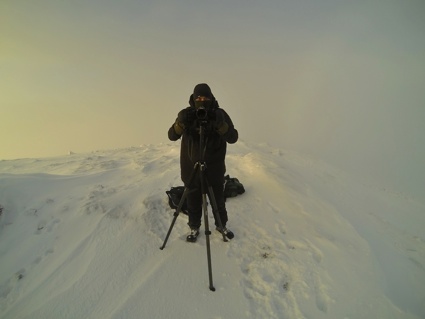
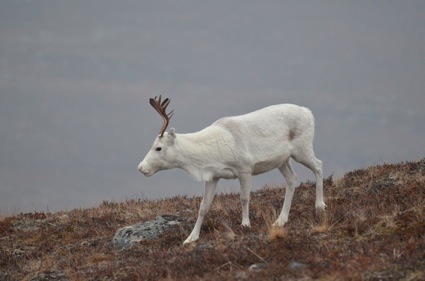
This week, i’m talking with French artist Benjamin Pothier who is currently frost-bound for an ARS BIO ARCTICA residency organized by the Finnish Bio Art Society at Kilpisjarvi Biological Station in Lapland.
Pothier is in the region to shoot videos and make sound recordings but because he a PhD researcher in Arts, Anthropology and Architecture at the CAIIA Hub of the Planetary Collegium, University of Plymouth, he is also investigating nomadic architecture, drawing lessons from the way nomadic cultures live in symbiosis with the environment and more generally exploring issues of global warming which are felt so acutely in circumpolar regions.
The artist had previously attended the FIELD_NOTES laboratory at Kilpisjarvi Biological Station and last year he had been invited as an artist to participate to the Arctic Circle Residency 2013, in the international territory of Svalbard.
I’m catching up with Benjamin while he is still in the Arctic and before he flies to South Africa to show his photos of icebergs in Johannesburg….
Benjamin Pothier, 8KNOT Trailer
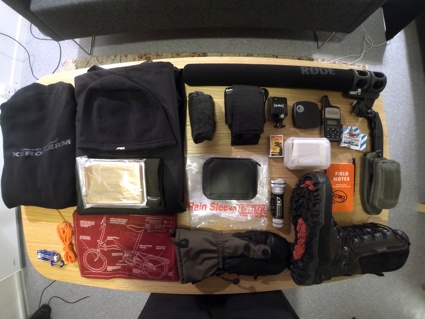 Hi Benjamin! The ARS BIO ARCTICA residency has an emphasis on the Arctic environment and art and science collaboration. Are you working with scientists over there? How?
Hi Benjamin! The ARS BIO ARCTICA residency has an emphasis on the Arctic environment and art and science collaboration. Are you working with scientists over there? How?
Well, I am not working with scientists right now as there are no scientists at the station at the time, I mean apart from me! What is specific to my work is that I am actually an artist AND a researcher. I am a researcher in anthropology, which is usually classified as a “Social Science”. But of course anthropology means much more than that for me. I have been driven to anthropology researches for intellectual and artistic reasons. I think the perspective on society one can gain through anthropological studies or research is quite similar to the position of the artist in our societies, and maybe even in traditional societies, as long as you consider the role of the shaman, which in my opinion is connected in many ways to the role of the artist in contemporary societies. But this is probably more an artist statement than an academic point of view.
As an artist i’m connecting to the site, the landscape, the nature and surroundings, through Photography and documentary film direction, but it is really a way to connect to the site. because all of this also include long walks, or staying still under snow or strong wind near an arctic lake shore, for example, to do video or sound recording. And the body is as much an interface with the landscape as the camera or the microphone.
Then as a researcher I try, and sometimes manage, to get an overview about theses experiences, mainly life in the arctic circle for this residency, in order to widen the frame of reference for my research.
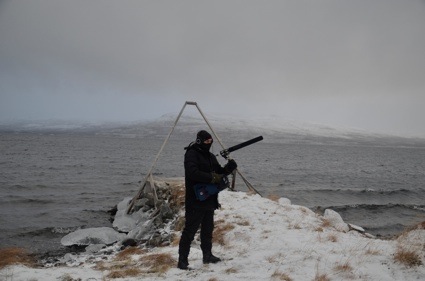 Sound recording on the Shore of Kilpisjarvi’s Lake 22/10/2014. -5°C strong wind
Sound recording on the Shore of Kilpisjarvi’s Lake 22/10/2014. -5°C strong wind
What brought you there? Because surely there must be art residency in more hospitable parts of the world?
I’m actually a PhD candidate at the CAIIA the Center for Advanced Inquiry in the Interactive Arts, in the program of the Planetary Collegium, which is supervised by the professor and artist Roy Ascott, and my research is focused on Circumpolar North Arctic and Subarctic Tribes… that’s probably one of the reason! But I would love to visit… hum… Vancouver or San Francisco for example ! I am also passionate about the art and craft of the Haida people of Pacific Northwest Coast of North America for example…
Well last year I’ve been selected for the Arctic Circle residency, organized by The FARM,INC, a NYC based cultural organization. And we went up to 20° from the North Pole. I find this kind of residencies challenging. And I like it. For the Arctic circle residency we had to take a zodiac boat every morning to go to the shore, protected by three armed guide against potential polar bears attacks, and it’s an “interesting” way to do film direction or photography. For me it was also a way to gain “field knowledge” on contemporary ways to “survive” in the arctic, through discussions with the arctic guide and a study of their gears and behavior.
As an artist I am also interested by that kind of harsh environments because it questions the place of humans on Earth… it’s connected to some of my pursuits, I am quite interested by the work of Survival research laboratories, for example, or the Makrolab created by Marko Peljhan, or Angelo Vermeulen‘s Seeker projects. I’m honestly a die hard fan of “old school Cyberpunk”, science fiction at large as well as bio-regionalism and vegan cooking… and to deal with rugged, waterproof or foldable technologies in this harsh environment, or to cook my vegan bolognaise with dried soy chunks in the station kitchen, all of these are experiences that fits with all those pursuits.
And well, of course the Arctic is NOT Antarctica, but I’m a big fan of the movies The Thing, the John Carpenter’s one and the quite recent prequel as well. So some of the experiences I’m living there are materials for future art projects, who knows? Art installations, short sci-fi movies or novels, but with strong first-hand field experiences as background. And some like photographing the landscape or directing a cross media project here are very concrete art experiences with a result in the short term.
The Arctic is the perfect place to engage into those kind of life and art experiences. I like being in a place where I can feel that nature is stronger than me, even if it is always a very calculated risk, I’m very cautious and I have a kind of “preppers” mindset. But in a “philosophical” point of view, when I’m saying that “Nature is stronger than me”, it’s probably because “I” like when “I” becomes “Nature” and there is no more “me” for a few minutes. that’s the reward. It’s a Zen type experience. I am really not the first human nor artist talking about that!
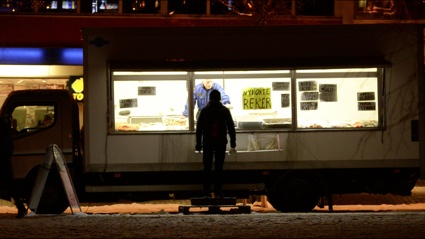
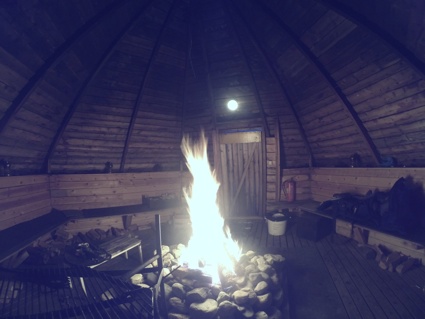 Fire inside the Kota
Fire inside the Kota
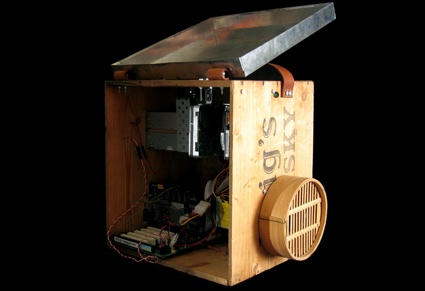 Benjamin Pothier, Maiitsoh (open)
Benjamin Pothier, Maiitsoh (open)
This is not the first time you are at the Kilpisjarvi research station. You first went there in 2011 for the Finnish Bioart Society’s Field_Notes workshop. So is this residency a continuation of the previous one? Or are you working on something entirely different?
Well I was working on something quite different at that time, an interactive documentary Installation about Computer History that I presented at the Computer Art Conference #4 CAC#4 in Rio de Janeiro in September, the project is called Maiitsoh: I’ve interviewed various people from William Gibson to Noam Chomsky, or John Cale, about topics dealing with computer history, consciousness and creativity, and I was working on that project at the time of the Field_Notes workshop. Maiitsoh is the Navajo word or more precisely the Dineh world because the so-called “Navajo” call themselves Dineh… And it’s more than time to give some recognition to the indigenous people. So it’s the Dineh word for the Wolf. It’s a direct homage to the code talkers during World War II, at that time the Dineh language was used by the Allies as an “analog” cyphering technique, while the Axis Countries where using a mechanical cyphering machine, the Enigma machine. The first ever modern computer ever built, Colossus, was actually built to break the Enigma machine code. It’s a part of history quite well known in the computer community. There is also a not that good movie directed by John Woo about the Dineh code talkers. I used the name Maiitsoh as a tribute to the Code Talkers, but also for it’s similarities with Macintosh. Maiitsoh is made of wood, like the first computer mouse or the first Apple computer… it’s really a multi scalar project. It’s about creativity, it’s a 3 or 4 dimensional Nodal point, in the Gibsonian perspective. it’s a wooden computer and it’s an icon of computer recent History. Forget about plastic, the first computers owe things to the wood!
Nowadays i’m very focused on my PhD research, which is a study of the patterns of the Ainu people, the aboriginal people of North Japan. It’s for me one of the most beautiful form of craft on this planet. This is a very subjective comment. As an artist, I just love the shape of their patterns.
But the subject is a bit wider. I am questioning the origins of arts and craft on this planet, basically. Why did the human species started to draw, to do sculptures, embroidery ? That is the question! I never take for granted anything that exists on this planet. Why do people wear pants made with denim fabric for example ? And why don’t we embroider our clothing nowadays ? What is an object ? Why do human grow those kind of vegetables in the area, and not other ones ? To get perspective is always a good way to make a daily fresh start and enhance your human experience.
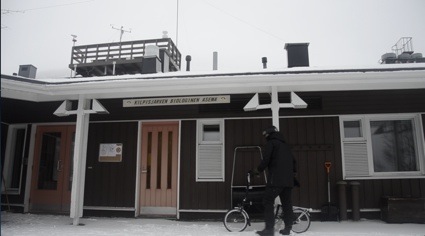
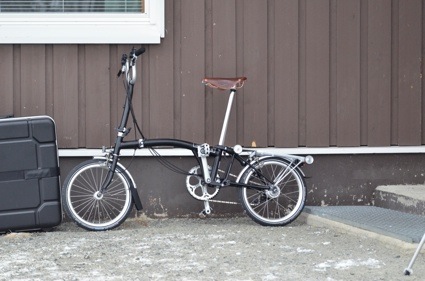 You brought a bike in the Arctic? Is it a very practical mode of moving around up there? What’s the story of the bike?
You brought a bike in the Arctic? Is it a very practical mode of moving around up there? What’s the story of the bike?
Yes, I brought a foldable bike there, a Brompton. For various reasons. First, It’s an artistic and activist statement, here in the Arctic which is of course one of the first region exposed to global warming. I am really pro-biking, I was even close to people from Critical Mass at a time. I am proud about that past. It’s a shame to see that people are so unconscious of environmental problems. Last year in Svalbard, at 20° from the North pole, we saw styrofoam on the shore. In that incredible landscape… and of course the invisible pollution is also quite dramatic… Species are disappearing , the arctic is melting, and I guess nobody forgot Sandy Superstorm… well , I don’t have a short term memory and I remember being already aware of those increasing problems in the 90ies… And you can really make eco-friendly businesses and make money. So come on! Humanity is a teenager trashing its room.
So it is in a way an homage to old friends from the activists community, to bring a bike here in the Arctic, and to use it to circulate around the station, or to go to the grocery store few kilometers from here, despite the wind and snow… But there is also something related to artistic performance, to use that quite “urban Bike” which is in a way the “Rolls Royce” of folding bikes, and to use it on hard snowy roads in the Arctic Circle. I also applied a kind of “artistic protocol” to the use of the Bike, which is a direct homage to Joseph Beuys piece I Like America and America Likes Me.
The bike never actually circulated nor touched the ground on a road before I took it out of its rugged case, here at the station. The same way Beuys didn’t touch the U.S. soil before being brought to that room with a live coyote… It was an homage to the political situation of “Native Americans”, and here in the North of Finland there are still Sami people, northern Europe’s last hunters and gatherers. So the title could be “I like Finland and Finland Likes me”, maybe ! hahaha!
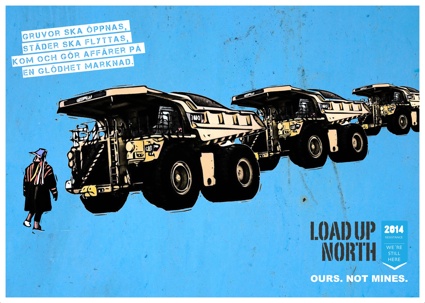 Suohpanterror, Blowupnorth
Suohpanterror, Blowupnorth
I don’t personally know them but I have seen some work by a collective called Suohpanterror, they do street art and art related projects dealing with the Sami identity. They are probably much more reliable than me to talk about the Sami question. What I can give as an artist is some visibility about the question. And of course for the bike performance itself, there are some unconscious parts I can’t myself explain. It’s like making a collage, but in 4 dimension and in real life, with an Arctic logistic, and a study of the possible ways to bring that bike to a research station. It’s very useful here for me, and it’s of course a bit burlesque to bring it here. I like that mix. It’s a very serious and complicated project, it’s suddenly completely absurd, and then it becomes really serious again.
I honestly thought that it would be a bit more challenging than that to use the bike. The Brompton works quite well on Sapmi’s roads…
And then of course the Brompton itself is a very amazing object. it’s manga like and also almost Steampunk . But it’s quite Beat-Punk for me. It’s a super contemporary object with that 1950ies or 60ies taste and quality. And I’m actually NOT paid to say that.
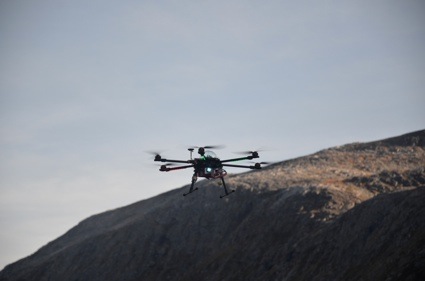
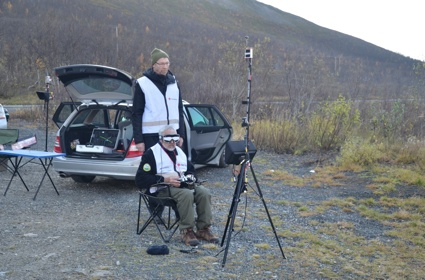 Drone FPV Training with the Search and Rescue Team from the Norwegian Red Cross
Drone FPV Training with the Search and Rescue Team from the Norwegian Red Cross
You’ve also been invited for a training session with people who use Drones for Search and rescue for the Norwegian Red Cross in the High Arctic. Can you describe the experience? Are you planning to apply to your work what you learnt there?
It was honestly a fascinating experience… As a researcher I have a kind of “classical anthropology ” approach, but as an artist I am more interested by digital anthropology or the anthropology of technology. Honestly i’ve been baffled to meet those people in Tromsø. I was missing some spare parts to make my drone works here in the Arctic, so I looked for forums in Norway on the internet, and two days later I was in contact with those people. And they are very skill full experts on that domain. Their practices are connected to many of my pursuits. I’ve been invited last year by European Union’s oldest program for collaboration in Science and technology to deliver a talk about the future of 3D printing. And then one year later, in Tromsø, on a rest area in a mountainous road I’ve met this guy who actually makes homemade and huge Octocopters, with 3D printed part that he designed himself.
I remember when there was no mobile phone, that’s something I always remember when I want to get some perspectives about the mutations of western societies, or the world at large. I don’t take technical progress for granted. It’s an organic process in perpetual evolution. It’s fascinating to realize what we can do in our ages with technology. People tend to forget about that. I never complain when Skype is slow… I’m always amazed to be able to talk in video with someone in California when i’m in Paris.
And well, for the experience of Drone and FPV, which stand for First Person View. It’s way more fascinating than what I imagined. It’s actually a physical experience to see through a camera which is flying 200 meters above yourself or at 1 kilometer from you… it’s a bit trance-like, or even techno-shamanic like. The only similarity I can find is when i used a 360° camera during a training at the SAT Society for Arts and Technology in Montreal in 2013, and when I was able to see my recording in the 360 dome theatre at SAT, the Satosphere. I had the same weird physical experience challenging my perspective on vision, the body, etc… very impressive!
And of course there is this satisfaction to realize that this technology is used to rescue people, to bring two ways radios or first aid kit to people stuck in mountains.
FPV in the Arctic is definitely an amazing experience. There is that contrast that I really like, I talked about that previously. To be in the middle of that impressive nature, and to be able to use the most up to date technology. So, yes, I will clearly apply to my work what I have learnt there, probably in the form of an installation, might be a short movie also, but it’s a bit too early now, I still have to integrate the process and the experience. I am really thankful to those people, and particularly people from FPV.no, Hi Kristian! :)
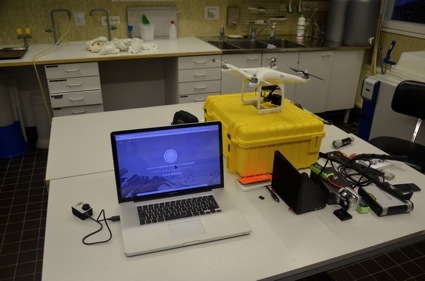
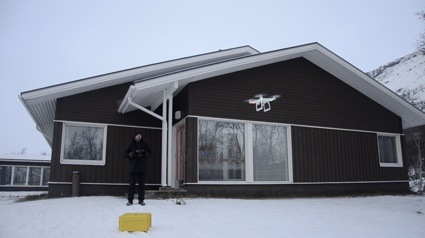 Quadcopter Flying test #1….
Quadcopter Flying test #1….
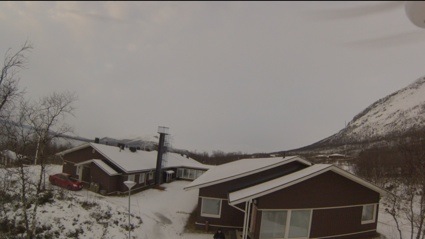 with aerial view of Kilpisjarvi’s Research station
with aerial view of Kilpisjarvi’s Research station
From what you told me by email about your residency, meeting people is an important part of your work. You’re also in contact with the Sami people, for example. How do they fit into your research there?
I am actually in a region that can be defined in many ways… I’m in North Finland, i’m in the Arctic Circle, but I am much more clearly in Sapmi, which is the proper name to describe this region, usually called Lappland. I prefer to use the word Sapmi, the land of Sami people. Lappland comes from Lapp which means rag in swedish. Honestly the Sami people are not the Indigenous people I know the most, I mean in terms of anthropology or basic contemporary History. I’m mostly here to do a comparative study of their decorative patterns. Well for me the residency is much more about feeling the landscape and the ways of living in the arctic.
Next month I am invited as a visiting scholar in Anthropology at the Center for Sami studies, at the University of Tromsø, in Norway. it is actually the northernmost university on earth, and the SESAME, center for Sami studies is at the forefront of Sami and Indigenous studies. They actually deliver masters in peace studies and in indigenous studies… quite an amazing place! There, I will meet Sami people and some colleagues from various countries in order to discuss my research.
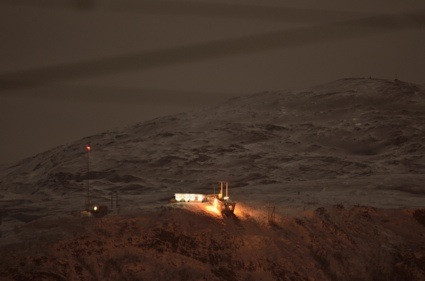
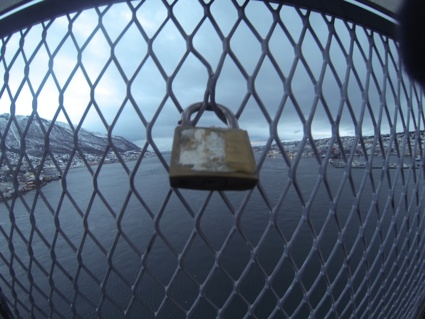 TROMSØ’S Bridge
TROMSØ’S Bridge
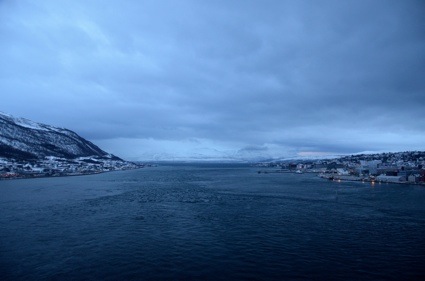 View of the Bay from TROMSØ’S Bridge
View of the Bay from TROMSØ’S Bridge
What’s next, after the ARS BIO ARCTICA residency?
Well in the short term, I will exhibit my series of photographs taken at 20° from the North Pole in Svalbard last year at Kalashnikovv Gallery, in Johannesburg, South Africa in December. The exhibition is organized in collaboration with the IFAS, the French Institute in South Africa. It’s really a great opportunity for me to be able to exhibit this Arctic related work in Johannesburg. And it will be another opportunity to talk about the arctic situation and the globalized aspect of the Climate question. I am very thankful to the IFAS for their support as well as to MJ Turpin, one of the owner of the gallery for the invitation. I think he definitely understand my work, which is something rare. He is also an artist and I really like some of his printed work and performances. South Africa is a very specific country, there is a very active art scene, as far as I know through discussions with my South African colleagues, and I had a glimpse of South African creativity last year at the Gaité Lyrique in Paris.
I’m really thrilled to be given the opportunity to exhibit my work in Johannesburg. Then I’m definitely looking for other residency opportunities, as well as planning a trip to Japan in the coming two years for my PhD research.
Thanks Benjamin!
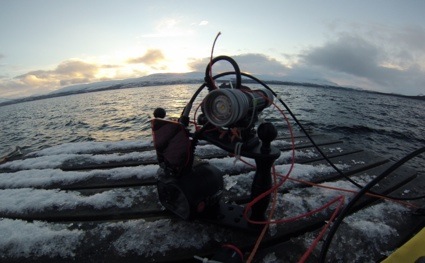 Preparing for some underwater video recording as well as sound recording at Kilpisjarvi’s lake
Preparing for some underwater video recording as well as sound recording at Kilpisjarvi’s lake
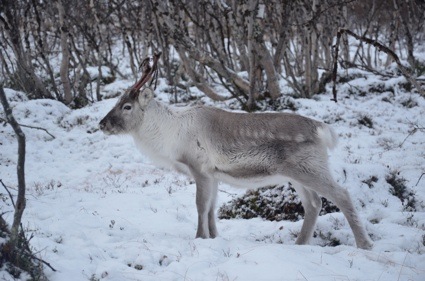 Reindeer in the forest near Kilpisjarvi’s research station
Reindeer in the forest near Kilpisjarvi’s research station
All images by Benjamin Pothier.
Related story: Field_Notes: From Landscape to Laboratory.
